|
Shortly before five o'clock
we drove by a large all-season waterhole with a few hippos
floating out in the middle; we remembered watching wild dogs trot
along here in the dusk on our last trip. A lone hippo entered the
water from shore, walking right through a flock of about twenty
little Fulvous Whistling Ducks.
Gee’s
radio crackled; the guides often radio each other when they find
something interesting – though being low season there was not a
lot of radio talk on this trip. “Roger, Roger, Roger,” Gee
replied (he pronounces it Ro-jure,
Ro-jure, Ro-jure, always repeating it three times). He told us
another guide had sighted a leopardess in a tree. We headed toward
its location; driving fast on the bumpy road. “Stay in the
vehicle,” Gee advised, looking back at us over his shoulder.
(Good advice, but this can actually be quite challenging
for those in the back seats.)
We paused for a small troop of
baboons beside the road; we stayed to watch them a few minutes.
Their leader was a huge male who looked quite fierce; we
remembered what Gee had told us about the aggressive baboons in
Savuti. A female was walking along with a baby clinging
upside-down to her stomach.
The
leopard was gone by the time we got there, maybe because we had
stopped for the baboons. Gee took us to a hyena den. Several other
vehicles were there as well. We could see the entrance of a large
burrow in the sandy soil; we sat there quietly, hoping the babies
would come out.
We
some watched starlings building a nest, and a squirrel running
over a termite mound. We listened to the refrain of the doves as
they chanted Bots-wa-na,
Bots-wa-na, though tonight it sounded to me like they might be saying
Look farther, Look farther.
We sat there for over an hour
before a young hyena face finally poked up out of the den for a
few seconds. A quick look and it was gone again. Finally at seven
an adult (mom?) walked by in the near-darkness, checking us out.
Then she moved on - too many vehicles, no doubt. We moved on as
well.
Darkness
fell, and Gee was sweeping the spotlight back and forth as he
drove. Unlike the national parks, in Khwai we were allowed to
drive at night. Gee’s light fell on a quickly moving shadow; we
got a quick glimpse of another leopard.
There
was a rush of wind and feathers as a Giant Eagle Owl swooped by
us. A Scrub Hare crouched timidly in the grass. Gee used a red
filter on the spotlight whenever he sighted an animal or bird, so
as not to impair their night vision. It was always his goal to
give us a great view of the animals, but without affecting their
behavior. We startled a hippo beside the road, glowing scarlet in
the red spotlight.
Earlier Paula had asked Gee what
made a sound like ‘whip-poor-will,
ha ha ha’, that she had heard in the night. Now we heard it
again; it was a fiery-necked nightjar.
Gee
stopped and the land cruiser in the middle of an open field,
turning off the motor. The evening air felt fantastic, and we
listened to the night sounds. Gee always knows how to find his way
from place to place, and knows exactly where to go, even at night.
He asked us how we think he does it. Does he navigate by the
stars? By maps? No. He knows all the roads and paths from
travelling them over and over again. He has memorized the tracks
and the rivers, and learned where the animals like to go, he told
us, and all of the ways of the bush are in his head. We considered
ourselves lucky to be able to benefit from his vast experience in
these parks.
Gee
continually shined the spotlight up into the trees, looking for
the glint of eyes. After a while he spotted a Bush Baby. These
tiny, nocturnal, arboreal primates have huge eyes, mobile ears and
long bushy tails. We had a glimpse of him in the trees, sitting on
a branch with his tail hanging down.
Then we
saw Springhares! The spotlight caught the glint of their eyes as
they were hopping along near the road. These darling nocturnal
rodents are about the size and shape of a small rabbit, but they
hop on their large hind legs while holding their tiny front paws
up in front of them. Springhares look just like tiny kangaroos; I
think they are one of Africa’s best kept secrets.
|
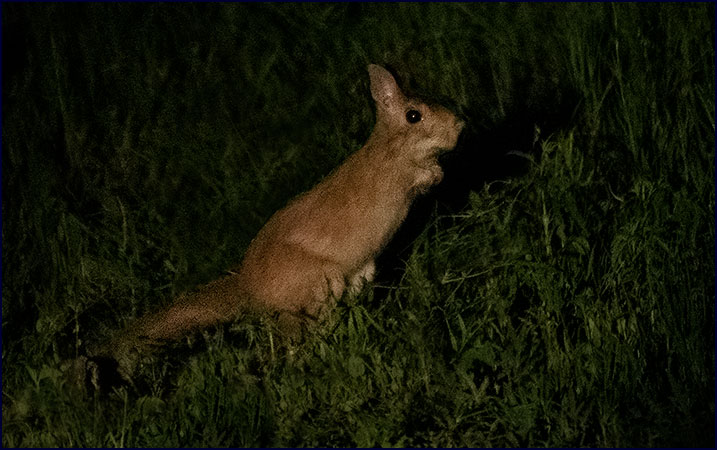
Springhare
|
We saw
lightning strike the ground in the distance many times, but we
could hear no thunder. This seemed odd, but distances are
deceiving – we realized because the land was so flat we could
see the lightning from much further away than at home. As we
neared camp there was a much closer flash of lightning,
accompanied by a loud crack of thunder. We thought we might get
wet, but the storm moved off across the dark plain. Dinner was
waiting when we got back to camp.
February
12
We heard hyena calls in the night
again, and lions in the morning. It rained hard from three to five
a.m. Our wakeup call didn’t come until 5.30; we got to sleep in
because of the rain. We had our usual breakfast of hard-boiled
eggs and avocado on toast, and then we were on our way.
The bush was rain washed, with
everything fresh and clean. The water droplets clung to the
leaves, getting us wet as we brushed by them. Maybe today I would
have a chance to get that photo of the lion shaking the raindrops
off his mane.
An egret perched at the very top
of a dead tree, and below it walked a new bird, the Hadeda Ibis.
It is named for its distinctive call; Ha!
Ha-aa-a-a.
A
beautiful waterbuck stood in a rain-drenched meadow, looking at us
over his shoulder. He had magnificent twisted horns, and the white
target marking on his rump stood out in the dim morning light. Gee
told us that waterbucks don’t taste very good to many predators.
Wild dogs don’t hunt, them but lions will eat them.
|
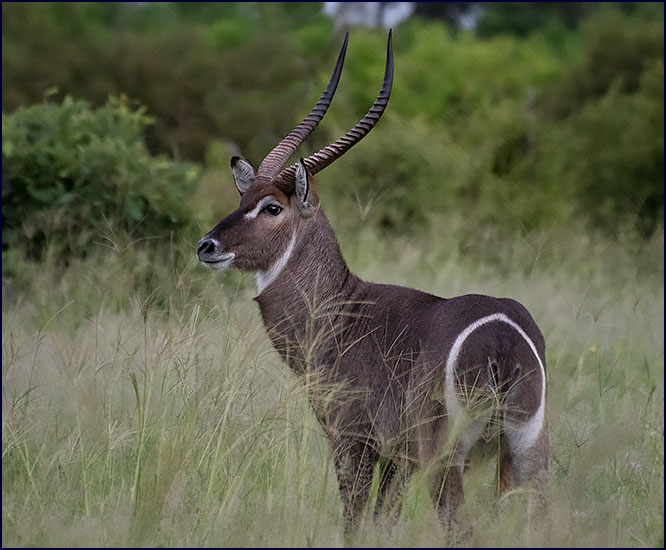
Waterbuck |
It
started raining. I got a considerable amount of grief for having
asked yesterday if it ever rains during the rainy season; it seems
I was now to blame for the precipitation. Gee handed out excellent
waterproof ponchos.
We came
to a lovely glade with a few big trees. It was raining steadily,
and the light was dim. Gee spotted a female leopard with a
recently-killed impala. She was dragging it across a field,
huffing and puffing – it was very hard work. She panted with
exertion; the impala weighed as much as she did. The leopardess
would stop to rest for a few moments, and then get a new grip on
the impala’s neck and set off again, dragging it between her
front legs and underneath her belly. This was repeated over and
over as she slowly worked her way across the field.
A herd of
impala stood facing the leopard in the misty rain, making alarm
calls. I was surprised they didn’t run away, but Gee said they
knew she was not hunting now, and they wanted to be able to keep
an eye on her and know where she was. We noticed the leopardess
had already eaten some of the impala; it must have been last
night’s kill. There were large dark holes where its eyes had
been; she had apparently eaten the eyeballs first– they must be
a delicacy.
The
leopardess was looking up, scanning the trees. Finding one that
suited her, she dragged the impala to the base of the tree and
stood sizing it up, judging the effort she would need to make. I
didn’t see how she could do it – as hard a time as she had
dragging the carcass across the field, how would she ever get it
up into the tree? We watched in awe as she grabbed it by the neck,
rocked back and made a huge effort, leaping and scrambling up the
trunk, dragging the impala along with her. She reached a fork high
off the ground and paused to rest there for a few minutes. At
least the impala was a female so there were no horns to catch on
things.
Our
leopard hoisted the impala again and climbed higher, making her
way up a slanting branch a good twenty feet above the ground. It
would definitely be safe from the hyenas there. She wedged the
carcass securely on the branch, and then gathered herself and
nimbly leaped over it, moving further up the limb.
Then she
rested, lying draped over a branch with her legs hanging down in
that signature leopard pose. Amazing. The only thing that could
have made it better would have been brighter light for photos.
After she
had rested a while the leopardess got up and stood on the high
branch for a few moments, silhouetted against the sky. Then she
came down out of the tree. She walked head-first down the steeply
angled branch to the fork, and then leaped nimbly to the ground.
She marked her territory, and then walked off toward a waterhole
for a drink. We did
not follow, but left her to her privacy. I had secretly wished to
see a leopard in a tree, but this beat my wildest expectations.
Unbelievable. Leopard number four, and one of our best all time
sightings. The leopard talisman was working like a charm.
We had
spent about an hour with the leopardess when we moved on. It was
still raining softly. We were watching some hippos navigate a
narrow winding river channel when Gee spotted a Malachite
Kingfisher sitting on some reeds by the water. This tiny beautiful
kingfisher is bright blue with orange and white markings, and is
spectacular. Gee also pointed out two birds that are endemic to
the Okavango Delta; the Hartlaub’s Babbler and the
Coppery-tailed Coucal. Wet and bedraggled, the coucal looked
miserable in the rain.
|
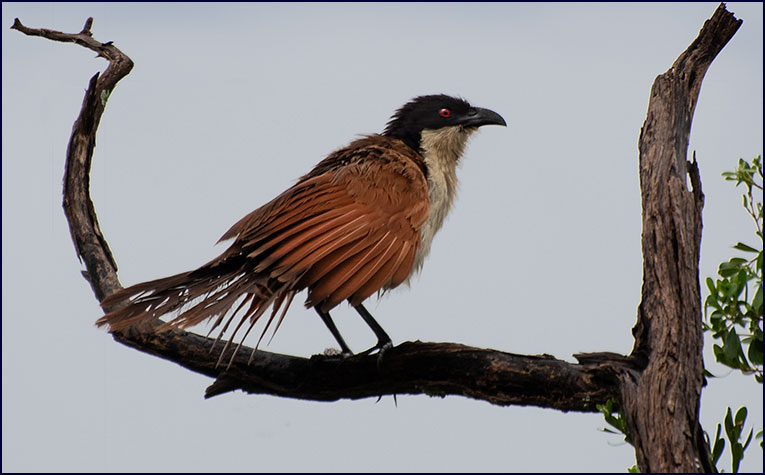
Coppery-tailed Coucal
|
We
stopped for tea by the Chobe border. Every leaf and blade of grass
was covered in rain droplets, as if laden with pearls. We asked
Gee to tell us the whole story about the leopardess and her kill.
Here is what he said:
‘I
got a radio call that a leopard was in a tree, with a hyena
sniffing around. Even a single hyena will take the kill from a
leopard. The leopardess made the kill in the night. She would
stalk the impala, hide in the cover and attack from 3 to 5 meters
away. They can chase down a baby impala but not an adult. Then she
would have immediately gutted the impala, and then buried the
entrails because they can be smelled for miles. Then she ate some,
including the eyes.
The hyena was probably a young and
inexperienced one, and it left the tree – it probably had found
the entrails. Immediately the leopardess started to move the
carcass, to get it out of reach of hyenas. We came along just then
and watched her carry the impala to the tree.
Our leopardess’s mother had held
this area; then she extended her territory, and gave the old
territory to the daughter. Then after the daughter had babies, the
mom pushed her out to a smaller territory.
When leopards have small babies,
they move them every three days or so. They will hide them in
thickets, hollow logs, or up in a tree. Even small babies can
climb very well; they will climb to the very top of a tree. But
leopards can’t climb palm trees. I once saw one climb another
tree, and then leap three meters into a palm tree. They can grab a
baboon, fall out of the tree, twist around in mid-flight and land
on the baboon.’
A small
flock of helmeted guineafowl moved through the grass and across a
log, hunched against the rainy weather. These striking birds have
black and white speckled feathers, bright blue and red heads, and
a horny knob on the top of their heads. They have a noisy call,
often sounding an alarm if they sense danger.
|
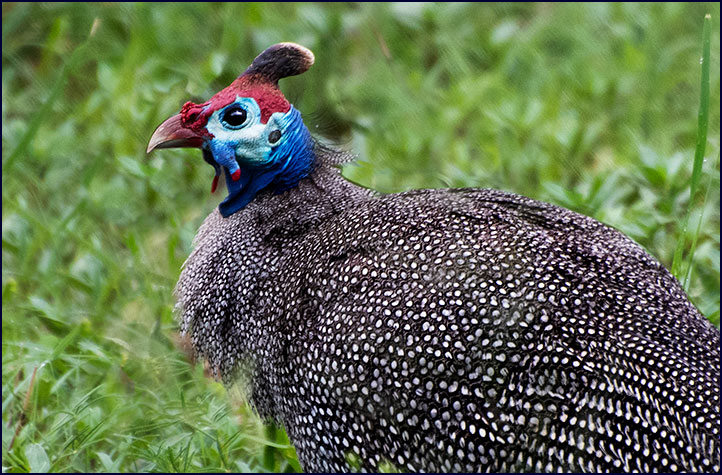
Helmeted Guineafowl
|
A group
of vervet monkeys were walking through a wooded area, and a few of
them were climbing high in the trees. A big male displayed his
vivid sky blue balls; they can control if they show the family
jewels or keep them hidden. If another monkey shows his balls, the
dominant male is likely to castrate him with his teeth. Female
vervet monkeys find the blue balls desirable.
|
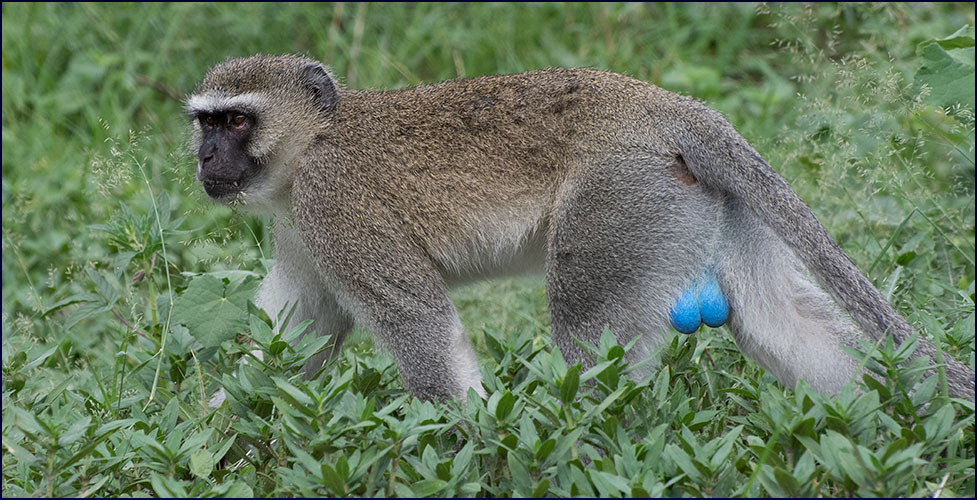
Vervet Monkey
|
We passed
through an elephant forest; this was an area filled with dead
trees killed by the elephants. The limbs looked like earie
outstretched hands. I wished I could explain to the elephants
about conserving their resources. A lone elephant walked among the
dead trees. Gee told us that animals like to come to the elephant
forest because it is open, but the dead trees still give some
cover. A tawny eagle gazed down regally at us from a high branch;
his feathers were tawny bronze intermingled with dark.
|
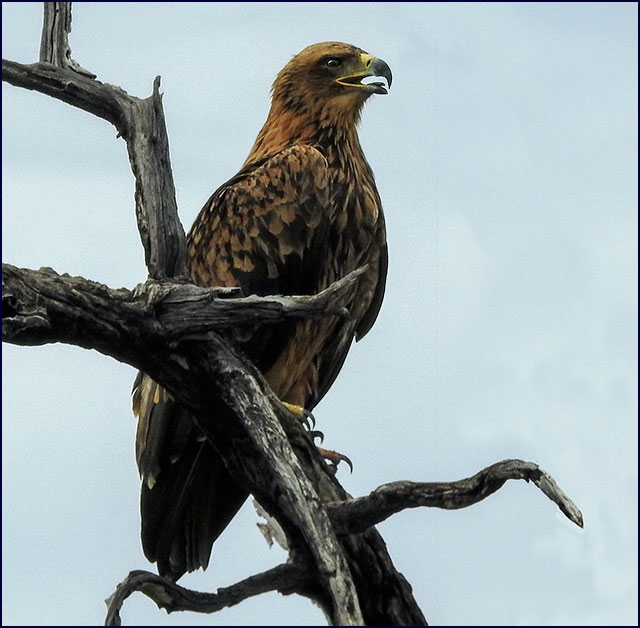
Tawny Eagle
|
We saw a
beautiful butterfly, and I wondered why there seemed to be so few
of them here. Gee told us about the government’s efforts to
control the tsetse fly:
‘The flies nest in camelthorn
acacia trees, so they decided to kill all of those trees. After a
while that was stopped. They considered killing the top two host
animals, buffalo and warthogs, but then they realized that humans
are number three; if you kill 1 and 2 they will come after us.
Then they used DDT, which killed all the butterflies. Finally they
developed baited traps, and managed to mostly eradicate the tsetse
flies in Botswana.’
A jackal
scrutinized us from a distance, and a pair of impala with a small
baby watched us warily. A Slender Mongoose climbed out on a log,
yet another elegant member of the mongoose family.
A
White-backed Vulture sat in a dead tree, giving off a grim reaper
sort of vibe. Soon we found the reason he was there; we passed the
carcass of a dead elephant. It had been dead a while, and the
smell was overwhelming. Flies buzzed all over it. Ugh! Gee paused
so we could take a look, but I was wishing he would just drive on.
We came
to a lovely lagoon; a striking black and white Sacred Ibis stood
at the edge of the water, along with some Egyptian geese and
white-faced ducks. A fish eagle perched in a high tree, his
mournful cry wafting down through the mist. We admired the
graceful lines of an African darter, with his slender racy head
and neck and his duck-like feet. Just beyond him in the water the
serrated ridges of a crocodile’s back broke the surface.
|
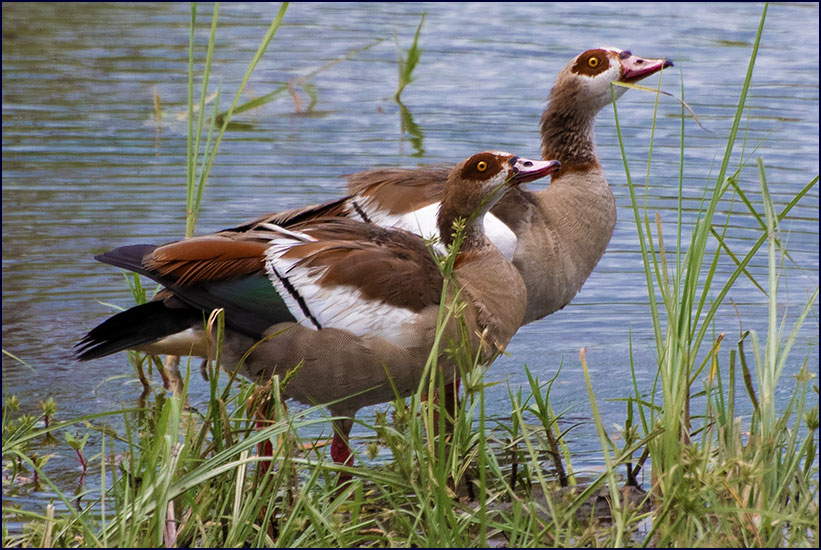
Egyptian Geese
|
Out
across the bushveld black clouds were rolling in, the stormy light
making for dramatic landscapes. In a reversal of last night’s
meteorological show, now we could hear the thunder but could not
see any lightning. But either way, a storm was definitely coming.
It started pouring rain. We
huddled in our ponchos as we drove back to camp. My earlier
question about rain in the rainy season was blamed for this
downpour; it seems it may have brought on bad juju.
We
got back to camp around noon, earlier than usual because of the
weather. We ate lunch and then took a nap.
|
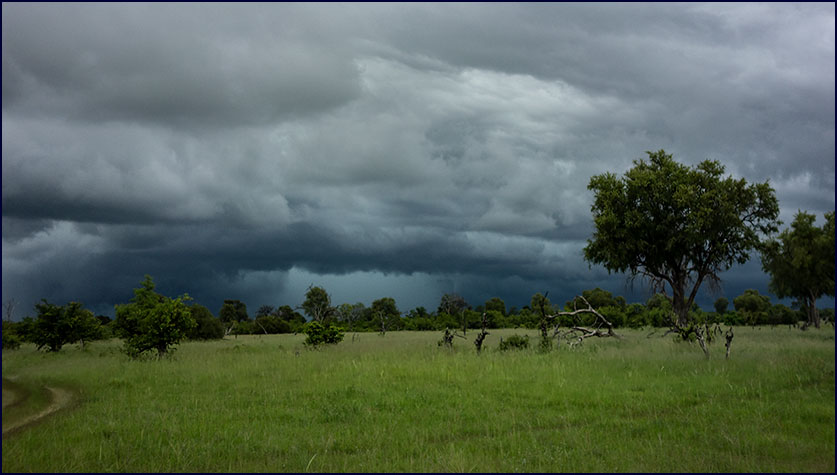
The Rainy Season |
It was
still raining lightly when we went out at four. We bundled up in
the ponchos and set off, fortified by high tea. (We usually
skipped tea because we came in for lunch late and went back out
early, but on this occasion it was much appreciated.)
Went took the main road, and
almost immediately we found wild dogs, five of them, standing in
the road in the rain. They disagreed about which way to go. Three
of them wanted to take the road ahead of us, and the other two
wanted to go back the other way.
|
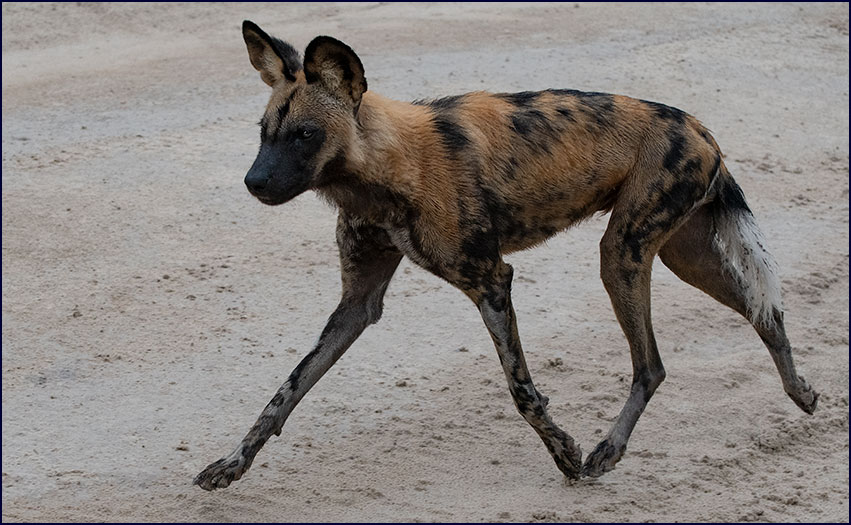
African Wild Dog |
Two of
the dogs trotted right past our land cruiser, pausing to urge the
others to come along. They started to follow, but then suddenly
turned back and went the other way. Not wanting to be separated,
the first pair went back to try to convince the others to change
direction. This routine was repeated several times, back and
forth. While the elders were having this discussion, two of the
younger dogs chased each other several times around the truck.
We were
happy for the opportunity to watch the dogs in action close up.
They were lean and fit, with strong necks and powerful jaws. A bit
like a German shepherd head on a greyhound body, but with huge
round ears. After a while they came to an agreement on direction
and went off through the trees trying to find the rest of their
pack, and we moved on as well.
A Greater
Painted Snipe was wading near the edge of a waterhole; he was
quite beautiful, marked in brown, black, white and chestnut.
A Yellow-billed Egret flew by in the rain. Another brood of
baby Egyptian geese waddled after their parents.
We were
able to get quite close to a small herd of wet zebras. The
wise-looking old stallion had a broad head with a roman nose, and
the scars of many battles could be seen on his coat. One of the
zebra mares had a small foal about a month old, still with his
fuzzy baby coat. The mother was missing her tail, probably from a
close encounter with a lion. The baby stood wet and bedraggled in
the rain, looking somewhat miserable. Two half-grown youngsters
stood scratching each other’s withers, but after a while they
started to bite and wrestle, mock-fighting. An elephant walked
sedately past behind the zebra herd.
Presently
the rain stopped. A huge bull elephant crossed the road and walked
right in front of us; the ends were broken off his tusks. He
stopped by a tall tree stump and started rubbing his chest and
stomach on it, scratching himself blissfully for a long while.
More male
elephants strolled up; now there were five of them. Two big bulls
challenged each other, advancing on each other assertively. One
would charge forward as the other backed away, and then they would
switch; back and forth they went. One of them almost backed into
the land cruiser. Up close and personal with the elephants!
The bulls moved at each other
again. We wondered what would happen - would this be a mighty
fight? But instead of attacking, this time when they came head to
head one of them wrapped his trunk tenderly around the other’s
tusk, and they stood there companionably. Apparently they had just
been playing a game.
We went
back to check on our leopardess. She was asleep in the tree with
her impala, lying over a branch with a front leg hanging down.
After a while she got up, looked around watchfully, and then lay
down again. She restlessly shifted positions several times.
Finally she went over to the carcass and ate some more; the impala
was about half gone.
It was a
fabulous sunset, and the air was cool and fresh as we drove into
the darkening evening. A starling perched on a dead tree, framed
against a crimson sky. We were startled as something big buzzed by
us; it sounded like a monster horse fly but then was gone. A giant
eagle owl perched in a tree.
The brilliant sunset lingered as
the fierce red sky melted to shades of pink and mauve. That
buzzing noise came again; it turned out to be a Carpenter Bee,
over two inches long - it sounded like a small aircraft, or
perhaps a drone.
Gee shone the spotlight on a Rock Monitor Lizard, stretched out on a
branch high in a tree. He looked almost like a snake at first. His
head was hidden in shadows, but we could see his long scaly body
and legs. As we drove on we saw a
Fiery-necked Nightjar, a scrub hare hiding in the dark, and more
of those amazing little springhares.
Another another giant eagle owl gazed down at us wisely from
a tree.
|
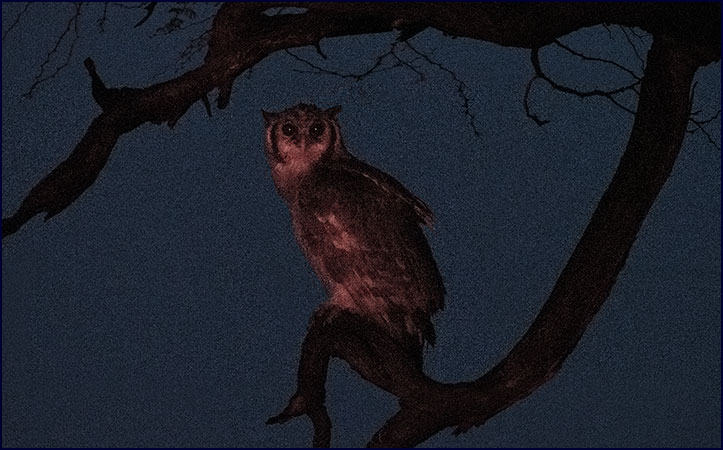
Gant Eagle Owl |
Gee
stopped the cruiser by a marshy area, turned off the motor and
told us to just listen. There was an incredible chorus of frogs
singing and croaking. We could hear four or five different songs
at the same time, all in harmony with each other. It was
absolutely beautiful. Gee said they sing like that just after
rain. This is always my favorite part of the night drives,
stopping in the dark to just listen to the sounds of the night.
When we
were almost back to camp we saw a hyena, no doubt lurking about
hoping to raid the kitchen later, or perhaps find someone’s
shoes left outside the tent.
No time for sitting around the
fire tonight; the crew called us to dinner right away with a meow call. A Sundowner Moth flitted around the table while we ate.
We heard the hippos laughing in the night, but our hyena did not
come back to visit.
February
13
It was moving day again, and we
set out early. We paused to watch a whole troop of baboons move
across the road and past us; there were about forty of them.
Several of the females had babies riding crouched on their backs
like jockeys. One baby sat up tall on his mother’s rump, leaning
back against her upward-held tail, looking around like he was
royalty. Another mom came loping along with her baby clinging
upside-down to her belly. Two adults walked toward each other in
the road and tenderly shared a quick hug. We watched them with
fascination.
The
baboons moved through the brush, not hurrying, but covering the
ground efficiently on their long nimble legs. Baboons are
athletic, graceful even. You could almost even consider them
beautiful, if it weren't for those ugly bald butts. The big
dominant male leader came by, heavily muscled and strong, ever
watchful. You wouldn’t want to mess with him.
Presently
Gee realized something was wrong with the trailer; he stopped to
check and found it was not closed properly, and two of the camp
chairs had fallen out. We went back and found them.
We went
to the hyena den that we had visited two nights earlier, and this
time there was plenty to see. Two mothers were lying near the den,
and there were four babies moving around. The smallest was about
two months old, the others three and four months. Gee said the
mothers come in the morning and feed the cubs, and then let them
play a while. When the cubs go back in the den, the mothers leave.
The
adults checked us out thoroughly, but they apparently decided we
were no threat so they went back to sleep. Meanwhile, the
youngsters cavorted around, treating our vehicle as a grand
adventure, daring each other to approach us. One of the would run
boldly up to the vehicle, look at us inquisitively, and then
scamper away in mock terror - then it would be another’s turn to
make the same daring approach.
They played this game over and
over, while the mothers watched indulgently. One youngster lay on
his back with his feet in the air and idly pawed the branches
above his head with his front legs. Hyenas don’t have a great
reputation, and the adults may be considered ugly by many, but let
me tell you, there are few things cuter than a baby hyena.
A pair of
Saddle-billed Storks wandered through a stretch of tall grass.
These storks are huge birds, almost five feet tall. They are vivid
black and white, with stripes of red and yellow on their bills,
and they have bright yellow eyes. They are one of Gee’s favorite
birds, and mine too.
|
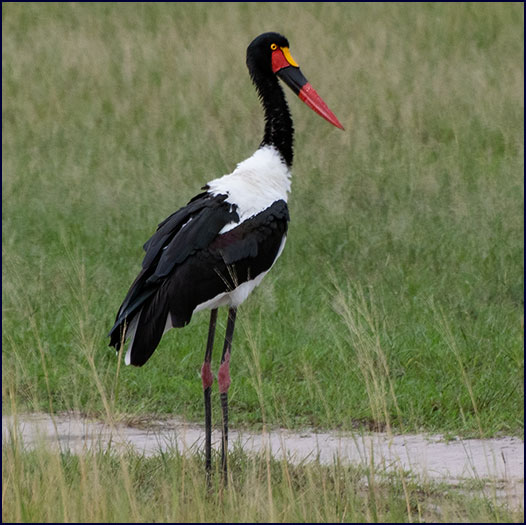
Saddle-billed
Stork |
We came
out to a wet grassy plain inhabited by a large herd of red lechwe.
There were dozens of these antelopes grazing, or loping along with
their peculiar downhill gait. Lechwe Plain, we called it. The
lechwe look amazingly off-balance as they move; they may be
Gee’s favorite antelope, but they remind me too much of a horse
on its forehand.
We
noticed a beautiful red lily with yellow edging; Gee said it was a
flame lily, and that it is very poisonous. If you eat one you die,
Gee told us, unless you boil it with milk - then it is OK. I
wonder if this is true? I wouldn’t want to test it.
On the new bird front, we saw an
Emerald-spotted Wood Dove and a Long-toed Plover. An African Crake
was taking a bath in a puddle.
The
clouds were rolling in and it looked like more rain was coming. We
could see black storm clouds in the distance with showers slanting
down. I was still getting grief for my earlier comments about the
rainy season.
We
watched some hippos in a narrow river, so close we could count
their whiskers. They floated with just their ears, eyes and
nostrils showing above the water. A baby hippo swam beside her
mother, impossibly tiny beside Mom’s huge bulk. She would
submerge for a while, and then suddenly pop back up.
We passed
through Khwai Village, with its small round houses with thatched
roofs, huts made with coke bottles built into the mud walls, and
the Water Lilly Tuck Shop
with murals painted on the walls. Several new houses had fences
stretching nine feet high to keep the elephants out of the yard,
with four or five strands of electric wire laid out horizontal on
the ground. We saw several cottages with their thatch roofs in
shambles; the baboons had torn them up. We passed a school, and
two little boys rushed out to wave at us - we waved back.
We crossed the pole bridge over
the Khwai River, briefly disturbing the egrets sitting on the
railings. We checked in at the Moremi gate, and Gee showed us
where we were on the big wall map. It started to rain gently.
|
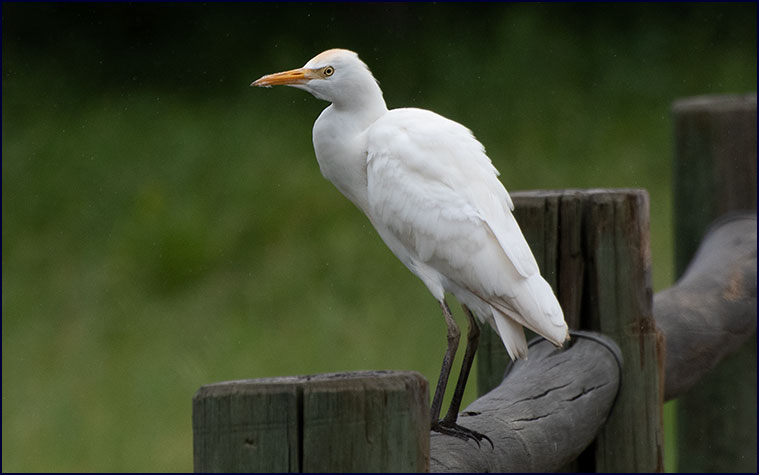
Intermediate Egret
|
We drove
along with the Khwai River on our right; we could see the Khwai
Concession that we had just left on the other side. We could see
muddy hippo paths through the tall grass and reeds. We were
welcomed into Moremi by lechwe, impalas and kudus. A raft of
hippos floated in the water, and a rather large crocodile lay
sunning himself on a mound. A giraffe watched us go by and a trio
of vultures peered down at us from a tree. A dwarf mongoose
watched us intently from a fallen tree. A juvenile African harrier
hawk clung to a tree, trying to rob a starling nest. As he flapped
his wings and tried to reach his beak into the holes he was mobbed
by the starlings.
Each winter the Delta is flooded
from rains that fell
months earlier, a thousand miles to the north in the Angola
highlands. This water flows down the Okavango River, filling
lagoons and flooding fields and plains. While some of the deeper
lagoons are permanent, the flooding is seasonal and in summer the
water recedes. The flooding of the Delta happens in the dry
season, and then as the floodwaters recede the rainy season comes,
so there is abundant water most of the time. This makes the area a
paradise for the wildlife. The Okavango has been described as ‘one
of the last best places on earth.’ It is rich with life
in amazing
diversity and glory.
|
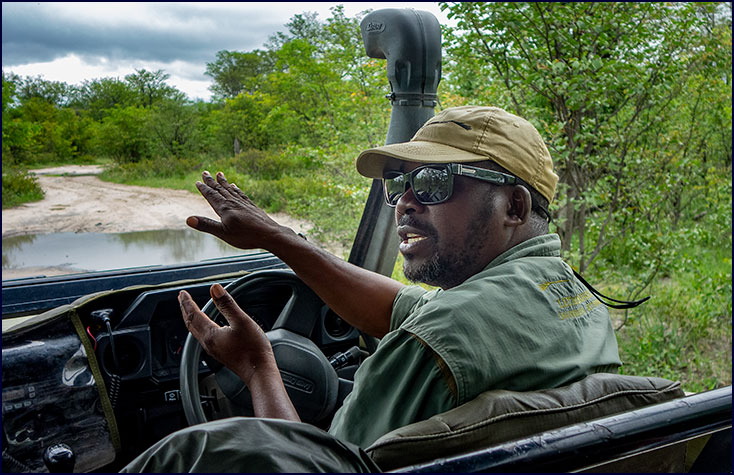
Gee
|
We
passed through an area of tall dead trees; Gee said that shifts in
the Teutonic plates under the earth changed the water flow,
flooding areas that had been dry for decades and killing the
trees. The sky was lightening up some and the rain was letting up;
now where was the photogenic lion with the raindrops in his
mane?
A ranger came by looking for a
missing self-driver; Gee told us the rangers are identifiable by
the red license plates on their vehicles. The self-drivers get
lost, stuck or in trouble quite often; we were much happier having
Gee for a guide. We could not have found a tenth of the things he
showed us on our own.
|